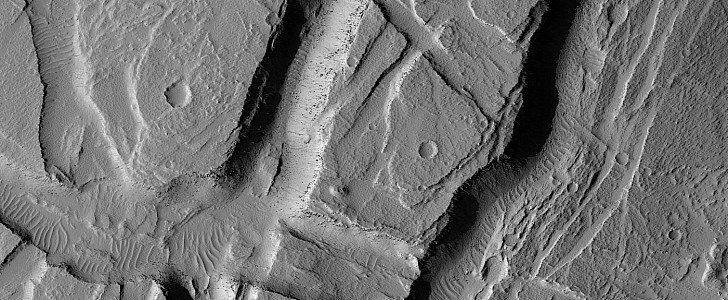I don’t know if it’s because Mars is such an alien place, or because it is inherently weird, but there’s at least one fact you can always be sure of when it comes to the neighboring planet: its surface does present shapes and patterns you’ll find nowhere in the solar system.
For years now, the Mars Reconnaissance Orbiter circling the planet has used the HiRISE camera to send back continuous proof of that fact. And the image we’re here to marvel at today is just another example of that.
Described by the scientists studying the photos as resembling “cracks in the crust of bread (not the cheap fluffy stuff in a bag but the nice stuff from the bakery),” these features might actually be yet another telltale sign of the fact that Mars once had water.
The features are located in an area called Echus Montes, a place left unexplored so far by land-based rovers. They resemble very abrupt hills, formed by the swelling of their interiors.
According to NASA, these swellings might have been caused by groundwater freezing or, alternatively, rising domes of salt. A third option, that of injections of magma coming from the planet’s core, is also considered as the cause for their formation.
This particular image, captured by HiRISE back in 2020 from an altitude of 273 km (170 miles), “looks at a particularly complex set of fractures on the surface.”
”These appear to record multiple overlapping episodes of fracturing which might mean that this mound was uplifted by multiple separate intrusions of magma that occurred at different times,” NASA says.
Regardless of how they’ve formed, these hills are yet another proof that the planet humanity is very likely to call a second home has a lot of secrets to uncover. Until we get to do that, we’re left with wondering at shapes and formations the likes of which we’ve seen nowhere else.
Described by the scientists studying the photos as resembling “cracks in the crust of bread (not the cheap fluffy stuff in a bag but the nice stuff from the bakery),” these features might actually be yet another telltale sign of the fact that Mars once had water.
The features are located in an area called Echus Montes, a place left unexplored so far by land-based rovers. They resemble very abrupt hills, formed by the swelling of their interiors.
According to NASA, these swellings might have been caused by groundwater freezing or, alternatively, rising domes of salt. A third option, that of injections of magma coming from the planet’s core, is also considered as the cause for their formation.
This particular image, captured by HiRISE back in 2020 from an altitude of 273 km (170 miles), “looks at a particularly complex set of fractures on the surface.”
”These appear to record multiple overlapping episodes of fracturing which might mean that this mound was uplifted by multiple separate intrusions of magma that occurred at different times,” NASA says.
Regardless of how they’ve formed, these hills are yet another proof that the planet humanity is very likely to call a second home has a lot of secrets to uncover. Until we get to do that, we’re left with wondering at shapes and formations the likes of which we’ve seen nowhere else.






